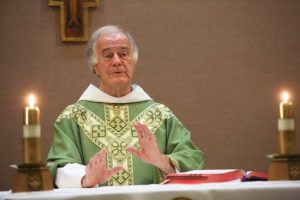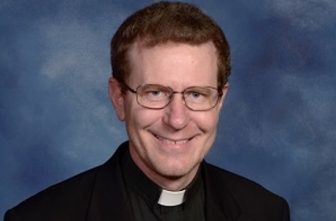
In 1216, St. Dominic responded to French Catholics’ need to be steered from heresy; in the 1860s, Dominican Bishop Thomas Grace served Catholic immigrants who needed churches and schools in the fledgling Diocese of St. Paul; and in 2016, local Dominicans continue to preach the Gospel and minister in new ways.
As the world has changed around them, St. Dominic’s followers in each generation have addressed the challenges of their time by sharing the fruits of their unbroken 800-year tradition.
This year, Dominicans are celebrating the 800th anniversary of the founding of their tradition of preaching, prayer, study and community. The anniversary, celebrated from November 2015 through January 2017, commemorates the order’s establishment through two papal bulls.
What began as one Spaniard’s vision today includes roughly 7,000 friars, 2,775 nuns and 26 groups of sisters in active ministry worldwide. Dominican priests, brothers and sisters are woven into the history of the archdiocese, and continue to make their mark.
“The charism that we’re trying to live — of contemplation, of prayer, of preaching and living the Gospel — is one that is desperately needed in this world that we live in,” said Dominican Sister Doris Rauenhorst, a Sinsinawa Dominican for 60 years.
That charism was given in the early 13th century to a young Spanish priest, Dominic de Guzman, who founded the Order of Preachers — aka the Dominicans — in response the Albigensian heresy, which claimed the spiritual world was good and the material world was evil.
“We don’t know as much about St. Dominic as we would like, but he left to us the order, the structure [and] the mission of the Order of Preachers, and that is his treasured gift to us,” said Dominican Father Patrick Tobin, 41, an adjunct professor of chemistry and campus minister at the University of St. Thomas in St. Paul.

St. Dominic’s order represented a revolutionary new movement of mendicant itinerant friar-preachers, who begged for their needs, traveled away from their monasteries and were active in the community. The order also signaled a shift from the prevalent all-monastic life to a life of both external apostolic mission, and cloister and prayer in community, said Dominican Father Mike Ford, director of the Dominican Shrine of St. Jude Thaddeus, a ministry of the Province of St. Albert the Great in Chicago.
Wherever they are, Dominicans pattern their lives after their founder’s four pillars of ministry, study, common life and prayer. The order was founded for preaching for the salvation of souls, but at the heart of its spirituality is the joy of following and being in relationship with Jesus, said Dominican Sister Mary Juliana Cox, 40, local superior of the Nashville Dominican Sisters of St. Cecilia and principal of St. Croix Catholic School in Stillwater.
While St. Dominic’s contemporary, St. Francis of Assisi, was called by Christ to rebuild the Church, Dominic was asked to rebuild the mind of the Church, Sister Mary Juliana said.
That included prayer. Tradition holds that Mary inspired St. Dominic to introduce the rosary, and the scene of Mary handing the beads to the friar is popular in western religious art.
After Dominic’s death in 1221, the life and mission of the order continued to grow. Study moved from monasteries to universities. The Dominicans contributed significantly to the development of theology, helping the Church find its voice in every age as the world changes, Father Tobin said.
Dominican St. Albert the Great (1200-1280) was a distinguished scholar and scientist. His student St. Thomas Aquinas (1225-1274), also a Dominican, was an intellectual giant who wrote on the roles of faith and reason, and continues to shape contemporary Catholic philosophy. St. Catherine of Siena (1347-1380), a tertiary Dominican, was also a theologian and philosopher, and notably helped to return the papacy to Rome after Pope Gregory XI took up residence in Avignon, France. All three Dominicans are doctors of the Church.
Minnesota influence
In recent centuries, the Order of Preachers has turned from its European focus to other continents for mission work, Father Tobin said. Dominicans established their first U.S. priory in 1806 in Springfield, Kentucky. Four years later, Thomas Grace was born in Charleston, South Carolina. He would become a Dominican priest in 1839 and the second bishop of St. Paul in 1859.
In 1865, Bishop Grace invited the diocese’s first Dominican sisters to Faribault where they founded Bethlehem Academy and Immaculate Conception School. The Wisconsin-based Sinsinawa Dominicans also founded other schools in the diocese, and nearly two dozen sisters continue to serve locally in a variety of areas, including the arts and music, pastoral ministry and assisting immigrants.
Other Dominican sisters, including the Dominican Sisters of Hawthorne, and the Dominican Sisters of the Sick Poor of the Immaculate Conception and Lucy the Martyr, have served the local Church in the 150 years since members of their order first arrived. In 2002, Archbishop Harry Flynn invited members of the Nashville Dominican Sisters of St. Cecilia to teach at St. Croix Catholic School. Currently four sisters live in Stillwater.
In 1878, Bishop Grace invited Dominican friars to establish Holy Rosary parish and priory in a south Minneapolis railroad community. The priory housed up to 20 friars and served as a hub for Dominicans who traveled by horseback and train to conduct missions in surrounding states.
By the 1930s, Holy Rosary’s burgeoning Catholic population compelled Archbishop John Gregory Murray and the Dominicans to form a second nearby parish, St. Albert the Great. Now serving as the Twin Cities’ priory, it is home to nine friars, some of whom have ministries outside the archdiocese, said Dominican Father Joe Gillespie, 73, St. Albert’s pastor for more than nine years.
As did their founder, Dominicans pray the Liturgy of the Hours and offer Marian devotions According to an ancient expression of the order, they “contemplate and give to others the fruit of that contemplation.”
Preaching still central
Lay Dominicans — men and women who live the order’s four pillars “in the world” — are also present in the archdiocese. They preach in their own lives, said Anna Marie Byrne, a lay Dominican and Holy Rosary parishioner who teaches at Risen Christ Catholic School in Minneapolis.
It “has big impact like a ripple in the pond when people connect with others,” said Byrne, 65. “It might be small ripples but it makes a difference in the example to others.”
The Dominican’s 800th anniversary is noteworthy because the order has never experienced schism, shifts or divisions, and it has a solid base of government, said Dominican Father Jim Spahn, 62, Holy Rosary’s pastor.
However, Catholics should pray for the order, said Sister Mary Juliana, including “for more zealous preachers who are courageous at a time when truth is not well respected or believed in.”
Father Spahn noted the need for preachers and the Dominican model will continue, and that the order has inspired a particular enthusiasm in the Southern Hemisphere.
“We need people who are willing to engage and seek out the truth wherever that’s to be found in a world that’s full of false values,” Father Spahn said. “Dominicans are geared toward things that will last [and are] very traditional, but at the same time willing to pick up and embrace new things and examine them.”




